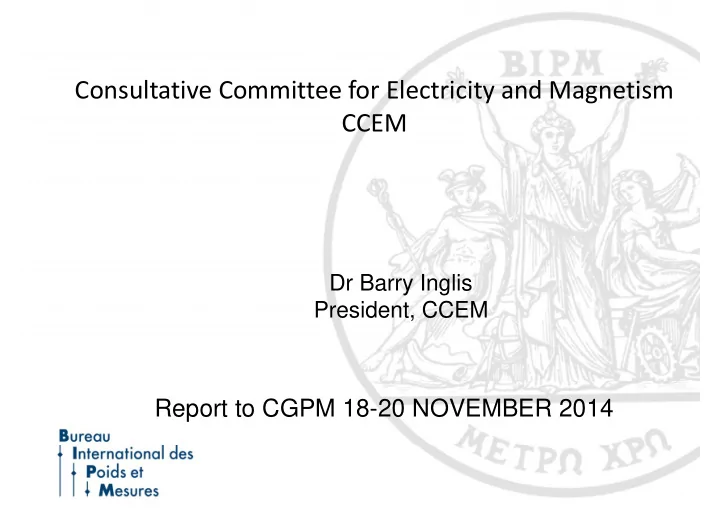

Consultative Committee for Electricity and Magnetism CCEM Dr Barry Inglis President, CCEM Report to CGPM 18-20 NOVEMBER 2014
Main Metrological Areas • Electrical quantities at dc and low frequencies • Electrical quantities at radio and microwave frequencies • Quantum standards • Electromagnetic fields • Magnetic flux and magnetic field strength • Dielectrics and properties of dielectric materials 2
Activities and achievements since the last CGPM • Preparation of a mise en pratique for the electrical units • Task Group established to consider implication for end users of expected 1x10 − 7 change for the volt. Led to presentations at NCSLI and CPEM conferences in 2014 plus publication • Regular review of key comparisons and CMC work ‐ load • Recommendation on simplification of CMC presentation to reduce the number of CCEM CMC entries in the database • Increased cooperation between RMOs to reduce duplication in the reviewing of CMCs • Agreement with RMOs on shorter deadlines for CMC review • Preparation of CCEM strategy document 3
Areas of Priority Support for the SI re ‐ definitions • Management of the expected change of the magnitude of the volt (1 x 10 ‐ 7 ) • Support for the Watt Balance • Development of an affordable, easy ‐ to ‐ use, reliable watt balance • Making quantum standards more versatile • • Travelling ac Josephson voltage standard, simpler QHR systems, ac QHR as impedance standard BIPM Key Comparisons • Effective and efficient processing of Key Comparisons and CMCs • Facilitation of collaboration between the NMIs of Member States • Strategic planning to address the demands of new and emerging • technologies 4
Inter-disciplinary Issues Measurements and standards for nano ‐ systems • • Nano ‐ bioelectronics • Molecular electronics • Nano ‐ magnetism • Carbon nanotubes New materials • • graphene THz metrology • Physiological effects of electromagnetic fields • • Magnetic resonance imaging • Cell phones • Power transmission lines 5
Future Strategy Reducing the workload related to the CIPM MRA in a field with many derived • quantities, often extending over a large range of values, by the design of efficient Key Comparisons and delegation to the regions to run further Key and Supplementary Comparisons according to need. Development of new travelling quantum standards to enable comparisons at • the highest levels of accuracy. Support technological developments in electrical instrumentation by making • quantum standards more versatile and more widely available Support electrical measurement in important new fields such as power • metrology and THz metrology. Collaboration in the development and comparison of electrical standards for • nano ‐ structures? 6
Recommend
More recommend